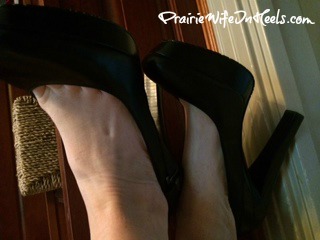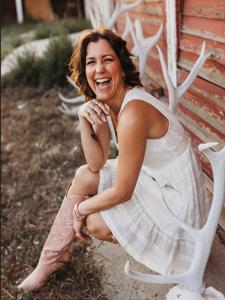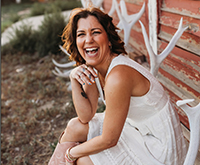Prairie Wife of the Week Oncologist
Posted December 12, 2014 by Texas Two Steppin' - 3 comments
This is a very, very special post for me, and I’m kinda nervous that I won’t be able to do this week’s Prairie Wife justice. You see, although I spend a portion of my “free time” blogging, I’m really not good at sharing my feelings with others, especially about personal stuff. Opinions on fashion, beauty, and heels, not a problem, but true feelings…problem. So when I became the first Prairie Wife of the Week and was asked to share my breast cancer story in October 2013, it was tough but I persevered because I wanted to let others know that bad news can lead to great things. Two months later, when I was diagnosed with cancer a second time, sharing the news with our readers came a bit more naturally.
But how do you share the story the incredible oncologist who not only saves your life but also understands the healing power of a new pair of heels? During the interview she described herself as “a cancer slaying prairie wife,” and I can vouch for her skill, dedication, determination as she attacks this killer disease. And while I’ve gotten to know her during my treatments and clinical trials, I so enjoyed getting to know more about this woman who decorates her exam room with photos of her beautiful children and makes rounds in four-inch heels. Alright, let’s get on with the interview and don’t forget to read the incredible story about the shoes that are pictured below

Texas Two Steppin’: Tell us a bit about yourself and your family.
Cancer Slaying Prairie Wife: I am an oncologist in Austin, Texas, and I specialize in breast cancer. I grew up north of Dallas, in Plano. I moved to Austin for my undergraduate, and after finishing over a decade of medical training in Houston, I was happy to return to Austin—where I call home. I met my husband over our cadaver (Doris) the first day of medical school. He is a cardiologist for children. Aside from being able to date someone in medical school who could also tolerate your formaldehyde stench (the cadaver smell-embalming fluid), it has been incredible to have a partner in life who places a high value on serving people by treating their chronic health conditions, has a deep understanding of demanding but meaningful work, and is willing to pick up the slack when needed. We have three children—12, 9, and 6 years of age—who are our greatest adventure.
Texas Two Steppin’: Why did you decide to specialize in oncology?
Cancer Slaying Prairie Wife: I wanted to be an oncologist because it is a remarkable time in oncology. The paradigm for how we treat cancer is changing so much within the past decade. We are able to do so much more than ever before. More patients are surviving this disease, and it is a great privilege to see them through it. Being a breast cancer specialist is also very gratifying. I get to help (mostly) women go through a very difficult time of their life and see them through to the other side—when they are cancer free. I have met so many amazing women in the process and it is a constant source of inspiration for me.
When I was in medical school, I saw my friend lose her father to CML, a chronic form of leukemia. In 1999, when I graduated from medical school, people with CML had an average survival rate of 5 years. In that time we had recently come to understand the molecular cause of this form of leukemia—a translocation in the 9th and the 22nd chromosome—and were developing treatments to target the cause. Clinical trials were underway for a drug called Gleevec, and in 2001 a landmark clinical trial was published in the New England Journal of Medicine showing an amazing response to this treatment for patients with CML. The drug was approved by the FDA in just two months. The 5-year survival for patients with CML had gone from only 50% to over 95% overnight with a new targeted therapy.
We were in a new era, an era of molecular medicine. This represented a tremendous paradigm shift in oncology—we were learning to do so much more. I feel like it must have been how doctors felt when they first discovered antibiotics. I had to be a part of this change. In addition to being a part of a field that was rapidly changing, I wanted to develop relationships with people and take care of them for long periods of time. Oncology allowed for all of those things, and I don’t look back and regret that choice.
Texas Two Steppin’: To me you have always been the doctor who gave me incredible advice and treatment so I could kick cancer’s butt not once, but twice. But in reading your biography, you are a distinguished doctor who has received many honors and awards related to breast cancer research and cancer public policy. Unfortunately, I didn’t have the opportunity to meet you to discuss breast cancer prevention. So let’s take some time and discuss it now.
You taught me that cancer is as individual as the women and men it impacts and there are certain things we can’t escape like genetics and our age. And, we all know that we should eat healthy, lower our stress levels, and exercise. Yet many of us don’t. So do you have any tips to help us give up the excuses like we are too busy, it won’t make a difference, etc.? What are the most effective actions we can take to decrease our odds of having cancer?
Cancer Slaying Prairie Wife: Great question, and great time to ask. It’s true not all cancer can be prevented (we don’t get to pick our parents and their risk), but there is a great deal we can do. For women, first and foremost, know your risk. Is their cancer in your family? What type? Have a conversation about this first with your family and then with your doctor. For women with a strong history of cancer, often we can predict risk with genetic screening or would recommend a different surveillance plan. For breast cancer, women should be doing a self breast exam and have an exam with their doctor annually. Colon cancer is also common, affecting 5% of Americans. Begin screening colonoscopy at age 50—if you are at average risk. If you have colon cancer or other cancers in your family, talk to your doctor about a need of increased screening.
For all patients, live a healthy lifestyle. Eat a diet that is rich in vegetables and fruits, lean protein, and complex carbohydrates—using fats and simple carbohydrates sparingly. Be physically active—exercise 3-5 hours per week. Don’t smoke. Reduce sun exposure with appropriate clothing, hats, or sunscreen. The basic message is screen for cancer and make healthy choices. It won’t prevent all cancers, but it will prevent or reduce the risk of death for so many of them.
Texas Two Steppin’: So many of us (myself included) are not faithful about performing our monthly breast exams. Why are these important, and what should be the first steps if something out of the ordinary is felt (besides not panicking)? And when should a woman schedule her first mammogram—is 40 now the norm?
Cancer Slaying Prairie Wife: Breast self exam is really important because many women find their own cancers. You can’t find it if you are not looking. Women of average risk should have mammograms annually beginning at age 40. 1 in 8 women get breast cancer. It is just common. I see women all the time that have cancer diagnosed early due to screening—and then are much more likely to survive it. For women with higher risk, a different screening strategy may be needed. You should discuss this with your doctor. Also, discuss the mammogram results with your doctor.
Texas Two Steppin’: The Internet is full of so many stories and websites with different and differing suggestions, remedies and horror stories. What online resources would you recommend for women interested in learning the facts about breast cancer or looking to support a friend or family member with the disease?
Cancer Slaying Prairie Wife: American Cancer Society (www.cancer.org), and National Cancer Institute (NCI.gov) are great resources.
Texas Two Steppin’: I know I really appreciated hearing that having chemo is not like you see in the movies (my reference point was Susan Sarandon in “Stepmom”) and severe pain is not the norm. As someone who participated in a clinical trial, I also know there is some incredible research being done, but what do you see on the horizon for treating and preventing cancer?
Cancer Slaying Prairie Wife: I am really excited about our targeted therapies. There are three strategies in breast cancer that I think are really exciting. The first is CDK 4/6 inhibitors that harness the body’s own immune system to fight cancer. They have shown a lot of promise in early clinical trials, and we have three trials ongoing looking at these agents. The next is targeted agents against Her2 amplified cancers. These Her2 neu positive cancers can be very aggressive, but we have many novel agents that can keep them in check. The last is parp inhibitors. These are useful in some genetically associated very aggressive breast and ovarian cancers—like “triple negative” breast cancer. They show a lot of promise, and I am so happy we are participating in these clinical trials.
Texas Two Steppin’: OK, now’s your chance to give us one wonderful or unusual healthy living tip and any final Prairie Wife words of wisdom that we just shouldn’t live without.
Cancer Slaying Prairie Wife: Life is a juggle. Me, and so many other Prairie Wives, have to learn to adapt and somehow find balance and persevere. Sometimes that is hard—especially when you are fighting cancer. A friend and partner of mine expresses this sentiment in a famous John Wayne quotation that I have come to know and love, “Courage is being scared to death—but saddling up anyway.” Saddle up, Ladies!
P.S. My heels have a story. I wore these heels five years ago when I attended an event for a local breast cancer organization that raises funds and has survivors make artistic bras—and some model them down the runway. That year one of my patients, who was modeling in the event, collapsed and had a cardiac arrest. In these heels, I climbed up on the runway, gave her CPR with a colleague, and my husband shocked her heart back in to a normal rhythm. She is now a 10-year survivor of cancer, a Prairie Wife, and mother of a beautiful 4-year-old little girl. As a doctor I have done several resuscitations, but no others in 4-inch heels in front of 600 people. Who has seen the miracles that I see? It is a great privilege to see the miracles that I see—even if it is not always bluebirds and lemonade.
Texas Two Steppin’: So very well said, Cancer Slaying Prairie Wife, and I give you credit for all of the bluebirds and lemonade I’ve experienced since we met three years ago. Thank you for doing this interview, thank you for being you, and, while these words are not enough, thank you for working your miracles on me.
While she has an incredibly hectic schedule, if you leave a comment here for Cancer Slaying Prairie Wife, we promise to forward it along. And as you make your New Year’s resolutions for 2015, please be sure to add monthly breast self-exams to your list.
Leave a Comment
3 thoughts on "Prairie Wife of the Week Oncologist"
Categories: Prairie Wife of the Week
Tags: , breast cancer, Breast Cancer Awarness, breast cancer prevention, breast cancer recovery, breast cancer support, cancer, chemotherapy, doctor, medicine, oncology, Prairie Wife
Previous Post « 5 Things They Never Told You About Labor and Delivery
Next Post ADHD Part 2: The Diagnosis »





Send her MY thanks for your bluebirds and lemonade, too.
As “Pa” said…a hundred times!!
What a great story! How funny that you met your husband over a cadaver….. I love the story about the heels, too!
Texas Two Steppin’. You did an excellent job!